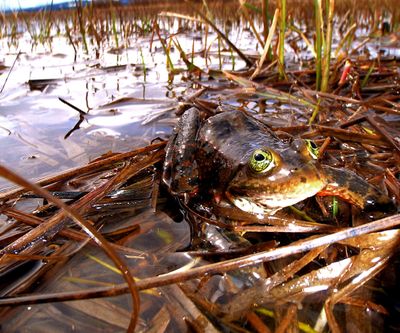Oregon spotted frog will be protected
Amphibian added as threatened species

GRANTS PASS, Ore. – Twenty-three years after it was first proposed for protection by the Endangered Species Act, the Oregon spotted frog is being listed as a threatened species.
The U.S. Fish and Wildlife Service is expected to publish its decision today in the Federal Register. It takes effect 30 days later.
Once common from the Puget Sound in Washington through the Willamette Valley in Oregon down and into Northern California, the frog survives in scattered locations in about 10 percent of its former range, mostly east of the Cascades, the service said.
The frog was first proposed for Endangered Species Act protection in 1991. Noah Greenwald of the Center for Biological Diversity said it is one of the many species that became mired in a backlog caused by political opposition to species protection and a lack of funding, until a settlement with the Obama administration put it on a timetable for consideration for listing.
The frog measures about 2 to 4 inches long, and it is marked by dark spots. The males make a call like a distant woodpecker tapping on a tree.
Habitat for the frog has been lost to urban and agricultural development, livestock grazing, the removal of beavers and the encroachment of non-native grasses, the agency said. Non-native fish and bullfrogs have eaten them.
A proposal for protecting critical habitat is not expected until the fall, so it is hard to gauge how much conflict with future development and grazing the listing might create, Fish and Wildlife spokeswoman Ann Froschauer said in an email.
Andy Blaustein, professor of biology at Oregon State University, said he was not optimistic about the Oregon spotted frog’s chances for recovery because so little habitat is left. Blaustein added that the low numbers made it unlikely to generate much conflict with developers, farmers or ranchers.
“It’s probably the worst-off amphibian we have in the state,” he said.
On the Fremont-Winema National Forest in southern Oregon, a rancher has been told to remove his cattle from a grazing allotment because his stock were straying behind fencing meant to protect frog habitat.
The remote and scattered sites where the frog survives amount to about 100 square miles and 24 stream miles, the agency said. In Oregon, the frogs can be found in the upper Klamath Basin and along the McKenzie River in Lane County and the Deschutes Rivers in Deschutes County. In Washington, populations remain in the Puget Trough and the Columbia River Gorge.
Restoration plans will focus on maintaining water levels in wetlands, putting beavers back into ecosystems, removing invasive grasses and removing non-native predators, Fish and Wildlife officials said.